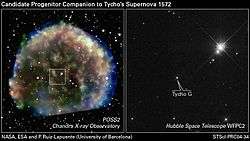Tycho G
| Observation data Epoch J2000 Equinox J2000 | |
|---|---|
| Constellation | Cassiopeia |
| Right ascension | 00h 25m 19.9s[1] |
| Declination | 64° 08′ 18.2″[1] |
| Apparent magnitude (V) | 17 |
| Characteristics | |
| Spectral type | G2 IV[1] |
| B−V color index | 0.60 [1] |
| Astrometry | |
| Proper motion (μ) | RA: −2.60 [1] mas/yr Dec.: −6.11 [ ±1.34] [1] mas/yr |
| Details | |
| Mass | about 1 [1] M☉ |
| Radius | 2 [ ±1] [1] R☉ |
| Luminosity | about 1 L☉ |
| Temperature | 5750[1] K |
| Metallicity | about 100% Sun [1] |
| Other designations | |
| Database references | |
Tycho G is the surviving binary companion star of the SN 1572 supernova event.
The star is located about 7500 light-years away in the constellation Cassiopeia. It is a subgiant, similar to our Sun in luminosity and color but more evolved.
Tycho G is still close to the center of the supernova remnant and had triggered once the explosion of its binary companion white dwarf star by contributing mass to it.
Evidence for companion hypothesis
- Tycho G is traveling at a rate of 136 km/s, which is more than four times faster than the mean velocity of other stars in its stellar neighbourhood.
- Tycho G's metallicity is about 3 times higher than the mean metallicity of other stars in its stellar neighbourhood.
Origin of the name
The supernova SN 1572 is often called "Tycho's supernova", named after Tycho Brahe who observed the "new star" in 1572.
The postfix "G" originates from the candidate companion stars considered, labelled Tycho A to Tycho V.
See also
References
External links
- Discovery of the binary companion of Tycho Brahe's supernova
- http://jumk.de/astronomie/special-stars/tycho-g.shtml
- http://www.skyandtelescope.com/news/3309696.html?page=1&c=y
This article is issued from Wikipedia - version of the 6/2/2016. The text is available under the Creative Commons Attribution/Share Alike but additional terms may apply for the media files.
